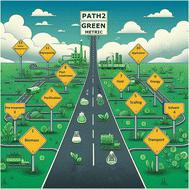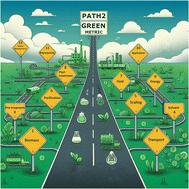Path2Green: 引入 12 项绿色提取原则和新的衡量标准,以评估生物质增值的可持续性
IF 11.3
1区 化学
Q1 CHEMISTRY, PHYSICAL
引用次数: 0
摘要
我们提出了一种创新方法,以满足对高效、透明的评估技术的迫切需求,从而评估提取过程的可持续性。随着社会对天然产品需求的不断增长以及随之而来的生物质勘探热潮,确保这些工艺真正环保成为当务之急。提取天然化合物历来被认为是一种植根于古老实践的良性活动。然而,当代的提取方法如果管理不慎,也会对环境造成严重危害。认识到这一点后,我们开发了一种新的衡量标准--Path2Green,它是根据绿色萃取工艺的 12 项新原则专门定制的。Path2Green 试图提供一个超越传统衡量标准的综合框架,提供对从生物质收集/生产到整个过程结束的萃取活动对环境影响的细致理解。通过整合资源损耗、能源消耗、废物产生和生物多样性保护等因素,Path2Green 旨在对提取方法的可持续性进行全面评估。Path2Green 的意义在于它能够将复杂的环境数据提炼成简单易懂的指标。这有助于各行业的利益相关者做出明智的决策,使他们能够优先考虑更环保的开采方法。此外,通过设定明确的基准和标准,Path2Green 还能激励创新,推动可持续发展工作的持续改进,是一种全新的用户友好型方法。本文章由计算机程序翻译,如有差异,请以英文原文为准。


Path2Green: introducing 12 green extraction principles and a novel metric for assessing sustainability in biomass valorization†
We propose an innovative approach to address the pressing need for efficient and transparent evaluation techniques to assess extraction processes’ sustainability. In response to society's growing demand for natural products and the consequent surge in biomass exploration, a critical imperative arises to ensure that these processes are genuinely environmentally friendly. Extracting natural compounds has traditionally been regarded as a benign activity rooted in ancient practices. However, contemporary extraction methods can also significantly harm the environment if not carefully managed. Recognizing this, we developed a novel metric, Path2Green, tailored specifically and rooted in 12 new principles of a green extraction process. Path2Green seeks to provide a comprehensive framework beyond conventional metrics, offering a nuanced understanding of the environmental impact of extraction activities from biomass collection/production until the end of the process. By integrating factors such as resource depletion, energy consumption, waste generation, and biodiversity preservation, Path2Green aims to offer a holistic assessment of sustainability of an extraction approach. The significance of Path2Green lies in its ability to distill complex environmental data into a simple, accessible metric. This facilitates informed decision-making for stakeholders across industries, enabling them to prioritize greener extraction practices. Moreover, by setting clear benchmarks and standards, Path2Green incentivizes innovation and drives continuous improvement in sustainability efforts, being a new user-friendly methodology.
求助全文
通过发布文献求助,成功后即可免费获取论文全文。
去求助
来源期刊

ACS Catalysis
CHEMISTRY, PHYSICAL-
CiteScore
20.80
自引率
6.20%
发文量
1253
审稿时长
1.5 months
期刊介绍:
ACS Catalysis is an esteemed journal that publishes original research in the fields of heterogeneous catalysis, molecular catalysis, and biocatalysis. It offers broad coverage across diverse areas such as life sciences, organometallics and synthesis, photochemistry and electrochemistry, drug discovery and synthesis, materials science, environmental protection, polymer discovery and synthesis, and energy and fuels.
The scope of the journal is to showcase innovative work in various aspects of catalysis. This includes new reactions and novel synthetic approaches utilizing known catalysts, the discovery or modification of new catalysts, elucidation of catalytic mechanisms through cutting-edge investigations, practical enhancements of existing processes, as well as conceptual advances in the field. Contributions to ACS Catalysis can encompass both experimental and theoretical research focused on catalytic molecules, macromolecules, and materials that exhibit catalytic turnover.
 求助内容:
求助内容: 应助结果提醒方式:
应助结果提醒方式:


